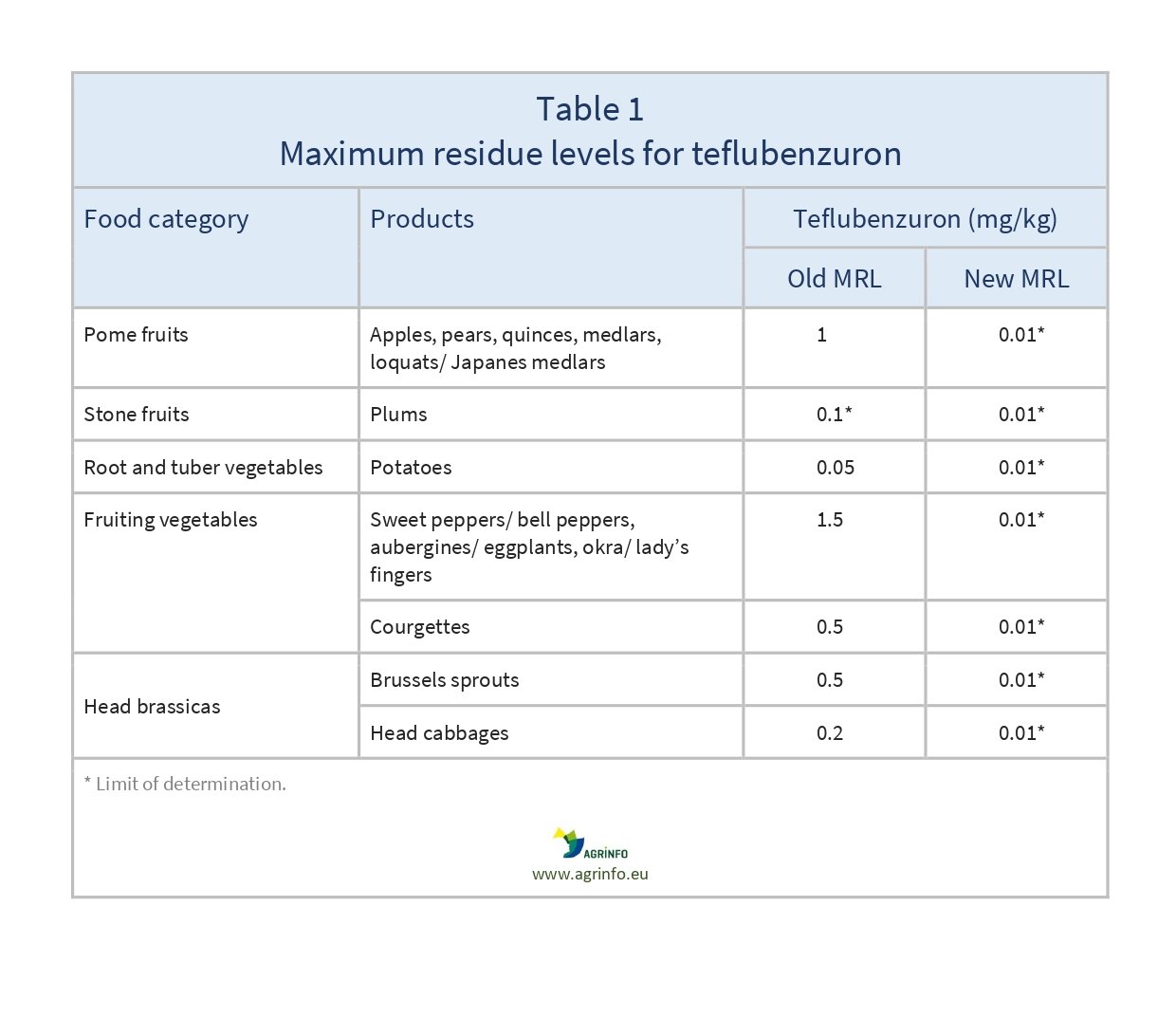Maximum residue levels for teflubenzuron
- Pesticide MRLs
Summary
The EU has set the maximum residue levels (MRLs) for teflubenzuron at the limit of determination (LOD) of 0.01 mg/kg. (The LOD is the lowest level that can be detected using the most modern and reliable analytical methods.) Where the detection level of 0.01 mg/kg cannot be met due to technical limitations, the MRL is 0.02 or 0.05 mg/kg. There are exceptions for products for which EFSA considers that existing Codex MRLs or import tolerances are safe – these include citrus fruits, grapes, papayas, tomatoes, cucumbers, gherkins, melons, sunflower seeds, soyabeans, and coffee beans. The reduced MRLs have implications for exporters of apples, pears, quinces, medlars, peppers, aubergines, okra, courgettes, Brussels sprouts, and cabbages.
EU reduces MRLs for teflubenzuron to 0.01 mg/kg on most products
Commission Regulation (EU) 2023/1783 of 15 September 2023 amending Annexes II and V to Regulation (EC) No 396/2005 of the European Parliament and of the Council as regards maximum residue levels for denatonium benzoate, diuron, etoxazole, methomyl and teflubenzuron in or on certain products
Update
The EU has set the maximum residue levels (MRLs) for teflubenzuron at the limit of determination (LOD) of 0.01 mg/kg. (The LOD is the lowest level that can be detected using the most modern and reliable analytical methods.) Where the detection level of 0.01 mg/kg cannot be met due to technical limitations, the MRL is 0.02 or 0.05 mg/kg. There are exceptions for products for which EFSA considers that existing Codex MRLs or import tolerances are safe – these include citrus fruits, grapes, papayas, tomatoes, cucumbers, gherkins, melons, sunflower seeds, soyabeans, and coffee beans. The reduced MRLs have implications for exporters of apples, pears, quinces, medlars, peppers, aubergines, okra, courgettes, Brussels sprouts, and cabbages.
Impacted Products
apples, pears, quinces, medlars, loquats, Japanese medlars, plums, potatoes, sweet peppers, bell peppers, aubergines, eggplants, okra, lady’s fingers, courgettes, Brussels sprouts, head cabbages, tree nuts, oilseeds, oil fruits
What is changing?
The EU has changed the MRLs for teflubenzuron as summarised in Table 1.
In addition, the LOD is reduced from 0.02 to 0.01 mg/kg on tree nuts, oil fruits, and oilseeds except sunflower seeds and soya beans.
Why?
Teflubenzuron is no longer permitted for use in the EU. The existing MRLs set for teflubenzuron have therefore been deleted and set to the LOD, except on certain products considered safe. Where the level of 0.01 mg/kg is too low to be detected by currently available analytical methods, the MRL is 0.02 or 0.05 mg/kg.
Import tolerances set for teflubenzuron on grapefruits and mandarins, that are considered safe by EFSA (2018), are maintained.
Codex has set MRLs for teflubenzuron on citrus fruits, grapes, papayas, tomatoes, cucumbers, gherkins, melons, sunflower seeds, soyabeans, and coffee beans. These are considered safe by EFSA (2017) and are therefore maintained.
Timeline
The new MRLs will apply from 8 April 2024.
Recommended Actions
Suppliers to the EU market of apples, pears, quinces, medlars, loquats/ Japanese medlars, plums, potatoes, sweet peppers/ bell peppers, aubergines/ eggplants, okra/ lady’s fingers, courgettes, Brussels sprouts, and head cabbages must find alternative solutions to existing use of teflubenzuron on these products by April 2024.
Products exported before 8 April 2024 that comply with the old MRLs will not be removed from the EU market after that date, even if they are not compliant with the new MRLs.
Background
MRLs are set in accordance with the rules set out in Regulation 396/2005. For information on current MRLs for other substances, please consult the EU Pesticide Residues database.
Resources
EFSA (2017) Scientific support for preparing an EU position in the 49th Session of the Codex Committee on Pesticide Residues (CCPR). EFSA Journal, 15(7): 4929.
EFSA (2018) Setting of import tolerances for teflubenzuron in grapefruits, mandarins and broccoli. EFSA Journal, 16(11): 5474.
Sources
Commission Regulation (EU) 2023/1783
Tables & Figures

Source: based on Regulation (EU) 2023/1783
Disclaimer: Under no circumstances shall COLEAD be liable for any loss, damage, liability or expense incurred or suffered that is claimed to have resulted from the use of information available on this website or any link to external sites. The use of the website is at the user’s sole risk and responsibility. This information platform was created and maintained with the financial support of the European Union. Its contents do not, however, reflect the views of the European Union.
EU reduces MRLs for teflubenzuron to 0.01 mg/kg on most products
Commission Regulation (EU) 2023/1783
What is changing and why?
Changes to the maximum residue levels (MRLs) for teflubenzuron are set out in Table 1.
Actions
For all products in Table 1, it is recommended that suppliers review their current use of teflubenzuron and explore alternative solutions.
Timeline
The new MRLs will apply from 8 April 2024.
Tables & Figures

Source: based on Regulation (EU) 2023/1783
Disclaimer: Under no circumstances shall COLEAD be liable for any loss, damage, liability or expense incurred or suffered that is claimed to have resulted from the use of information available on this website or any link to external sites. The use of the website is at the user’s sole risk and responsibility. This information platform was created and maintained with the financial support of the European Union. Its contents do not, however, reflect the views of the European Union.
